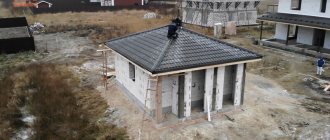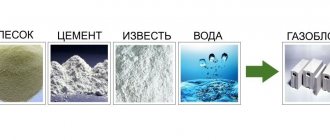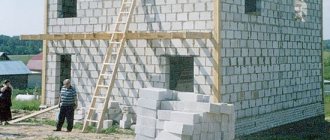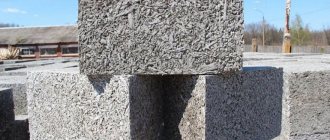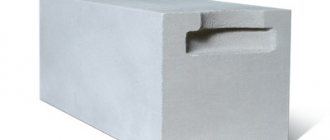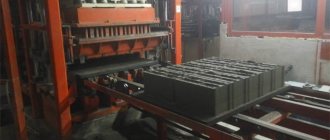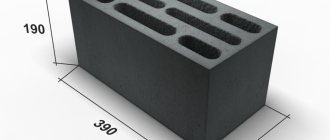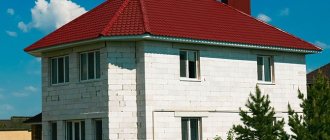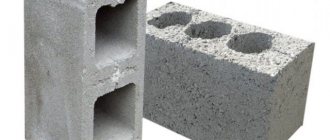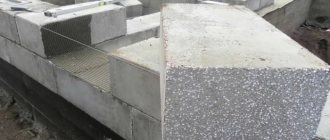Among the owners of a suburban area, the question of what material to choose to create a steam room from affordable products and at the same time with decent characteristics does not lose its relevance. After all, for many, the usual timber and logs turn out to be too expensive, so a cheaper alternative is a cheaper foam block. Such a bathhouse made of foam blocks has many advantages:
- environmentally friendly;
- easy to erect;
- when heated, does not emit harmful substances to human health;
- has high sound insulation;
- breathable and has a pleasant microclimate;
- does not shrink and retains heat.
In addition, baths made of foam blocks are fire-resistant, which is important. And even if it is small, but made in accordance with all the features and technologies for the phased construction of a bathhouse from foam blocks, the result will be a reliable, convenient and fairly durable structure. If you have doubts whether it is possible to build a bathhouse made of foam blocks on your site, taking into account its size, type of soil, communication capabilities, etc., weigh all the pros and cons, reviews of the owners of a bathhouse made of foam blocks.
We’ll talk about what a foam block bathhouse will be like 10 years later, but now read the step-by-step instructions for a foam block bathhouse to avoid mistakes.
The feasibility of using foam blocks
Baths made from this material are actually usually very inexpensive. In addition, foam blocks have almost all the same advantages as wood: they allow air to pass through (“breathe”), are very easy to cut, and are not too heavy. Their advantage, compared to timber and logs, is that they do not burn at all and do not rot. The disadvantages of walls made of this material include the fact that it is capable of absorbing moisture, while gradually collapsing. Therefore, projects for bathhouses made of foam blocks must be developed taking into account the characteristics of this material, in particular its hygroscopicity.
According to SNiP standards, it is prohibited to build baths from foamed cement. However, these rules were invented quite a long time ago. Since then, a huge number of new, modern materials with truly unique properties have appeared on the market. Foam concrete also belongs to them. In addition, SNiP standards were developed mainly in relation to public baths. Of course, in this case the rules must be very strict. A small country bathhouse made of foam blocks can become a very convenient and quite durable structure. But of course, only if all rules and construction technologies are observed.
Which foam concrete to choose for a bath?
The construction of block baths is still a fairly new branch in construction, so there are many points of view, the abundance of which can cause confusion.
We will try to outline all the features, starting with the fact that foam concrete comes in different types. Classically, all foam blocks are divided into 4 categories (classes, brands):
- D300-D500 (belong to the category of blocks with the lowest thermal conductivity, have a particularly porous structure, which affects their strength; suitable only as a thermal insulation layer);
- D600-800 (have an optimal ratio of strength and thermal insulation, well suited for the construction of a bathhouse, including as a material for load-bearing walls);
- D900-1200 (feature high strength characteristics, but require additional high-quality thermal insulation);
- D1300-1600 (rarely found, not produced in large quantities, belongs to the category of special orders, strength for the construction of a bathhouse is excessive, because it is more suitable for multi-story construction).
On a note! New products on the market include foam blocks with the addition of new components: wood chips, foam balls, etc. These additives contribute to the appearance of additional properties of the blocks.
The main difference is the weight range, which increases as the block's strength increases.
Since the production of blocks is strictly regulated by state standards, the gradation of sizes is clearly established and is:
- wall blocks for load-bearing (including external) walls: 200*300*600 mm;
- partition blocks for partitions (including internal and interior): 100*300*600 mm.
Almost every region presents foam blocks from different manufacturers; choosing from all the variety is not easy.
In order not to make a mistake with your choice, we advise you to pay attention to the following points:
- size of the blocks (they must have standard dimensions and correct shape) REFERENCE. It is enough to lay 2 blocks on top of each other and check how well they match: whether there are any overshoots or shortfalls. Full compliance indicates high quality.
- color of foam blocks (should be uniform gray, this indicates the correct manufacturing technology).
- grade (blocks of the first and second grade are found; the latter may have minor chips and unevenness on the edges).
- documents (it would be a good idea to request certification information: a sanitary certificate or a certificate of compliance with GOST).
It is advisable to choose products from large factories that can ensure compliance with production technology and will not risk their business reputation in the market. Such companies have catalogs and booklets on their product range, as well as certificates and other compliance documents posted on the website.
Carefully! The deviation of the price from the market towards a strong understatement should alert rather than tempt to buy. The production of foam concrete is gradually occupying its niche among novice entrepreneurs in the production sector, so the percentage of counterfeit products on the market is quite high
Advantages of a foam block bath
In addition to being cheap and having a rather pleasant microclimate, the advantages of such structures include environmental safety. When heated, foam blocks do not emit any harmful substances. In addition, they retain heat very well, meaning you will have to heat the bathhouse no more than once on a wash day. Since the foam block is not flammable, you do not have to comply with any special standards when installing the heater.
And of course, the undoubted advantage of this material is its ease of installation. Assembling a bathhouse from a log or timber is a rather labor-intensive task and at the same time technologically complex. Not everyone has experience in constructing such structures in our time. Probably any owner of a suburban area can lay out block walls.
Bathhouse designs made from foam blocks can be anything, that is, the owners of the site have the opportunity to choose the layout of this structure at their discretion. The material is easy to cut even with a regular hacksaw.
Building a foundation with your own hands
A bathhouse in a country house is a capital structure, so it is impossible to do without a reliable foundation. Let's look at how to do this with step-by-step instructions.
Which is better
The best option is a shallow strip foundation. You can, of course, use a monolithic slab or a pile foundation, but in this case it will simply be a waste of money.
How to choose the right type of foundation:
How to build
Required tool:
- concrete mixer or container for mixing mortar;
- welding inverter;
- hammer;
- bayonet shovel;
- building level;
- roulette;
- angle grinder (“grinder”);
- Master OK;
- hacksaw;
- rule;
- scrap;
- axe.
Example of a project with an attic and dimensions
You will also need consumables: cutting wheels, electrodes (1.8 mm), nails (60–80 mm).
Click to enlarge
How to build a foundation: step by step
The foundation installation process step by step:
- Clear the area of everything unnecessary, level it, mark the perimeter of the bathhouse using wooden stakes.
- Dig a pit around the entire perimeter of the future bathhouse, 50–60 cm deep and 30–35 cm wide.
- Stick steel pins (rebar) into the corners of the foundation and tie a thick thread to them.
- Using a level, accurately mark the upper horizontal line of the foundation (the thread will serve as a visual boundary).
- Manufacture and weld a steel frame from reinforcement with a diameter of 10–12 mm. It will be enough to place three rows of reinforcement at the top and bottom so that the total height of the foundation is 70 cm. For vertical elements, thinner reinforcement can be used, the step between them should be 1.5 m.
- Put together formwork from boards 25 cm wide around the entire perimeter. In the washing room, provide a hole for the sewer drain in advance by placing a receiving pipe with a diameter of 100 mm.
- Prepare concrete mortar by mixing cement with OPGS in a ratio of 1 to 4.
- Pour the solution into the formwork, align the top edge using the rule according to the level of the tensioned thread.
- Cover the foundation with a tarpaulin or thick burlap, take a break from working until the concrete has completely dried (14–21 days, depending on weather conditions).
A beautiful and elegant building that will decorate your site
At the stage of pouring the base of the bathhouse, a foundation for the bathhouse stove can be constructed in a similar way if it is planned to be built of brick. We also recommend that you familiarize yourself with the projects of brick baths.
The process of constructing walls from blocks is no different from similar actions when using ordinary bricks. However, due to the fact that the dimensions of the foam blocks are larger, the work goes faster. The best option for building walls is M25 blocks.
Disadvantages of foam block baths
The disadvantages of a bathhouse made of foam blocks are, first of all, dampness and destruction of the walls; in particular, saturating the blocks with water is dangerous in the winter. In a heated bath, vapors easily penetrate into the porous material. After the steam room cools, the water freezes and, expanding, simply breaks the concrete. Therefore, when building a bathhouse from foam blocks, special measures should be taken to waterproof the walls. In addition, the building will also have to be insulated. In this case, the walls will take longer to cool, and therefore, even if water gets into the material, it may have time to dry before freezing. In addition, much less condensation collects on insulated walls.
Experienced owners of suburban areas also recommend installing ventilation in such bathhouses. This will prevent stagnation of damp air, therefore extending the life of the walls.
Of course, all these tricks: waterproofing, insulation, ventilation - will cost the owner of the bathhouse a pretty penny. Therefore, structures for this purpose made of foam blocks are usually built only in steppe regions, that is, where it is difficult to obtain wood or it is very expensive. In forested areas of the country, it may be more advisable to build a wooden bathhouse. Most likely, it will not cost much more than paving stones.
Advantages and disadvantages of aerated concrete blocks for baths
The use of aerated block, according to experts, is a rational approach to landscaping the site.
In order for a bathhouse made of aerated concrete to bring pleasure to the owner and his guests for decades, even at the design stage it is necessary to take into account the following features of the material:
- lightweight design, the ability to perform construction operations without the use of special equipment;
- affordable cost - several times cheaper than wood;
- high strength, resistance to vibration and intense mechanical stress;
- excellent thermal insulation qualities (sometimes you can do without the additional use of insulation);
- immunity to the formation and proliferation of fungus and mold;
- Fire safety;
- optimal specific density, low load on the foundation.
Despite the abundance of advantages, there are also a number of disadvantages. If you order gas blocks with a low density, they may be excessively fragile. Some varieties have low thermal conductivity and ability to absorb moisture. These disadvantages can be minimized by choosing high-quality aerated concrete intended for the construction of steam rooms.
When talking about wooden bath structures, environmental friendliness comes first, but gas blocks also consist of natural materials
In addition, some users note such phenomena when using the material, such as:
- blowing through the masonry when using low-quality glue that does not provide the proper level of tightness;
- freezing of the binding row of bricks. It is preferable to replace brick ligation with polymer bonds;
- low temperature of lintels and armored belts - you can replace them with foam concrete floors.
Bathhouse made of foam blocks: price
The cost of such a structure will depend, of course, primarily on the layout and size. A wall foam block 60x30x20 costs about 2,500 rubles per cubic meter. A small bathhouse measuring 3x4 meters with one partition and a ceiling height of 2 m will require a little more than 6 m3. That is, the construction of the actual walls will cost about 16-20 thousand rubles. This will require about 5 m3 of mineral wool. It will cost about another 8 thousand rubles. About 2000 rubles will be spent on the glue solution. Thus, the walls of a small bathhouse made of foam blocks, at a rough estimate, will cost about 30 thousand rubles. Of course, to this amount you will need to add the cost of the foundation, lumber for the floor, ceiling and roof, waterproofing and lining.
A large 6x4 bathhouse made of foam block will, of course, cost more. It has recently become very fashionable to build attics on such structures. This is, of course, very convenient and allows you to save space on the site, but of course, it will additionally increase the cost of the structure. The walls and partitions of a standard 6x4 m bathhouse will require about 11 m3 of blocks.
Construction of a building
The process of constructing a bathhouse consists of several stages. Each of them has certain features that need to be studied in advance.
Foundation and floor
For a bathhouse made of expanded clay concrete, a strip foundation is suitable. Construction of the foundation:
- Mark the area for future trenches.
- Dig trenches 50–80 cm deep. The depth depends on the freezing point of the soil. The optimal width is 40 cm.
- Put together formwork from bars, boards, slats. Cover the inner surfaces of the boards with thick polyethylene film so that concrete cannot leak into the cracks. The height of the formwork is 50 cm.
- Install formwork panels along the trenches, connect them together, install spacers.
- Tie a reinforcing frame from reinforcement and place it in the trenches.
- Pour concrete and level it around the perimeter.
Next, you need to cover the foundation with film and wait 4 weeks.
Strip foundation (Photo: Instagram / fundament39)
Walls
Construction:
- Cover the frozen foundation with bitumen mastic, lay out 2 layers of roofing material.
- Before laying, the blocks must be placed in a container with cold water for 1 minute.
- Mix the masonry composition. Start laying walls from the corners. Check each block with the previous ones in terms of level.
- The bottom and top rows must have holes for joists and ceiling beams.
- After applying the solution and laying the blocks, remove any remaining adhesive with a trowel.
- Bandage every two rows. To do this, grooves are created in the row, which are filled with reinforcement.
It will be easier to align individual rows if you stretch the thread along each wall.
Windows and doors
The edges of door and window openings must be covered with metal corners. They also need to be installed at the top of the openings to support the blocks.
Ceilings and roof
For a bathhouse made of expanded clay concrete blocks, a gable roof is suitable. Assembly:
- The ceiling beams are fixed in the holes cut for them. They should extend beyond the walls of the bath by 50 cm along the edges.
- Individual sections of the rafter system are assembled at the required angle. They will be fixed to the overhangs of the ceiling beams.
- Separate sections are installed on top of the ceiling beams.
- The rafter system is assembled together using lathing.
The last stages are the installation of a vapor barrier film, counter battens, and roofing.
Scheme of a gable roof (Photo: Instagram / gasobeton)
Communications
It is better to lay communications at the initial stages of building a bathhouse, so that there are no problems during dismantling.
Electricity
For a bath, it is better to use wires with a special winding that can withstand high temperatures. They should be hidden in corrugations so that visitors cannot damage them. Switches and sockets are located in the dressing room.
Sewerage
It is better to use plastic pipes for sewer drainage. The drain must be protected by a grill to prevent large objects from falling into it.
Water supply
When laying water supply, plastic pipes should be used. The pipeline can be connected to a well, a well or a central water supply system. The part of the pipeline that is located outdoors must be buried in the ground or protected.
Well (Photo: Instagram / tumen.massiv72)
Wall treatment
Expanded clay concrete blocks absorb moisture. It penetrates inside, and when it freezes, it deforms them from the inside. To protect them from moisture, the blocks can be coated with a special compound that looks like dry cement or plaster.
- For hydro- and vapor barrier it is better to use foil film.
- When insulating rooms, you need to use different insulation materials. Mineral wool is suitable for the dressing room and relaxation area. For steam rooms and showers - foam materials, for example, foam glass.
- To obtain a ventilation gap between the film and the finishing, you need to install slats.
Construction of foundation and walls
Building a bathhouse from foam blocks is a simple procedure. Such a structure is erected in approximately the same way as a brick one. The difference is that the seams in the masonry of foam blocks are very thin, and special glue is used as a solution to hold the blocks together. When building even a small bathhouse from this material, it is advisable to reinforce the walls. To do this, in every fourth row, metal rods are placed in gutters cut out with a grinder. An armored belt must also be placed on top of the masonry.
It is recommended to make the foundation for a bathhouse made of foam blocks strip and quite powerful. All foam materials are fragile. And therefore, even with small movements of the soil, walls made of them can crack. For the same reason, blocks should be laid as evenly as possible, using piers, plumb lines and a level.
What is a foam block
Modern building materials differ significantly from their predecessors. Constant improvement leads to the fact that they become lighter, their performance improves, both strength and resistance to various aggressors, while the nominal cost decreases. Many people strive to build a house from foam blocks, the pros and cons, which are widely disputed by both professional builders and people who own such housing.
Foam blocks are a material that is gradually replacing cauldrons, bricks and other natural or artificial stones. Ideally smooth edges, low weight, as well as the ability to produce foam blocks yourself make this material attractive.
To produce foam blocks, foamed concrete mortar is used, which is poured into special collapsible molds. To obtain a cellular structure, gypsum, lime and, in some cases, aluminum powder are added to the solution. After pouring the solution into the molds, they are left alone until completely hardened. If necessary, finished foam blocks are trimmed and given a perfectly even outline. Quite often, foam block is confused with gas block, although they have completely different production technologies and are united only by the fact that they both belong to the group of cellular materials.
Bathhouse floors made of foam block
To prevent the walls from being saturated with water from below from the ground, it is worth installing special floors in such a structure. They need to be made concrete and slightly inclined towards the center. In this case, a receiving tray and a plastic drain are installed in the middle of the bath. The pipes should be laid underground below the freezing level and extended to the septic tank.
In order to extend the service life of concrete floors, they should be covered with tiled rough tiles. The base itself should be treated with penetrating waterproofing before laying it. In the future, special wooden gratings are usually installed on top of the tiles. After taking water procedures, they can be taken outside and dried.
Equipment and tools
To build a bathhouse with your own hands from foam blocks, you need equipment and tools.
Bayonet shovel.
Rubber hammer.
Hacksaw.
Master OK.
Tools:
- shovels – bayonet, scoop and mortar;
- hammer-pick;
- rubber mallet or mallet;
- plumb line;
- building level;
- rule;
- jointing;
- trowel or trowel;
- mooring cord;
- spatulas;
- notched spatula;
- hacksaw;
- roulette;
- hammer.
Hammer.
Concrete mixer.
Equipment:
- concrete mixer;
- container for diluting glue, cement and water;
- drill with whisk attachment;
- perforator;
- screwdriver;
- wall chaser;
- deep vibrator for removing air from the solution;
- stapler;
- ladder.
The project has been drawn, building materials and tools have been prepared, we move on to building a bathhouse.
Foundation waterproofing
This operation must be performed. In this case, you will get a durable bathhouse made of foam blocks. Reviews from owners about such buildings are not bad, but only if they are waterproofed according to all the rules. For the foundation of a bathhouse, both vertical and horizontal waterproofing are usually used. When installing the tape at the bottom of the pit, be sure to pour a sufficiently thick layer of sand. After the foundation concrete has gained sufficient strength, its top is glued with two layers of roofing material.
The walls of the base of the bathhouse must be protected from moisture both outside and inside. In this case, you can also use roofing felt. Penetrating agents are also considered a very good solution for waterproofing the foundation of a bathhouse. Sometimes the base walls are coated with bitumen mastic in two layers.
Reinforcement
Making a foundation for a bathhouse is impossible without reinforcement. For strengthening, choose reinforcement with a cross-section of 12 millimeters (for laying longitudinally) and 6-8 millimeters (for laying vertically and perpendicularly). To perform reinforcement, you need to prepare: wire, steel rods, an angle grinder, a tape measure, a welding machine (if you plan to weld the frame rather than knit it).
The structure is made up of 4 or more rods lying in three planes (longitudinal, perpendicular, vertical). The finished frame rises above the ground by at least 5 centimeters, the corners are further reinforced. The work is completed correctly if the cut of the armored belt turns out to be either a square or a rectangle.
Stages of creating a reinforcement frame for a bath:
Waterproofing walls
To protect the enclosing structures of the bathhouse from moisture, it is best to use foil vapor barriers. You can take special isospan or penofol. Today on the market there are foil materials designed specifically for baths. The waterproofing is secured to the wall with beams. The joints should be additionally nailed and taped on top with metallized tape. The lining is subsequently attached to the beams.
The ceiling of the bathhouse is usually made of boards. You can protect it from moisture by using impregnating waterproofing designed specifically for wood. A bathhouse with a foam block attic is very comfortable. However, when choosing just such a project, you should keep in mind that in this case, most likely, the roof will also have to be waterproofed from the inside. In the attics of baths, the microclimate is usually quite humid.
What types of blocks are suitable?
Block baths began to be built relatively recently, but experienced craftsmen have already left feedback on which blocks are best to use for the construction of the structure. Foam concrete blocks have different sizes and different densities - the strength of the material depends on this indicator. The more air that was used to create the foam during the production of the blocks, the less dense they will be.
Foam concrete blocks with a density of D600-D800 are suitable for the construction of a bathhouse. Blocks of this brand are perfect for building a sauna due to their good strength and thermal insulation. They will become the optimal raw material for the construction of load-bearing walls of the structure.
From the requirements for materials for a bath it follows that the raw materials must be reliable and withstand the effects of heat from the inside, and also not absorb moisture. Since foam concrete has the ability to absorb moisture, at the construction stage before finishing it must be treated with a water repellent.
Blocks of the D900-D1200 brand will be irrelevant here, as they require additional high-quality thermal insulation. Grade D1300-D1600 will be redundant due to its excessive strength: such material is used for multi-story construction. The most popular stone size is 600x200x300 mm.
Bath insulation
Next, let's look at how to insulate a bathhouse made of foam blocks. A structure made of this material can be insulated from the cold using both expanded polystyrene and mineral wool. The latter material is considered more preferable. The fact is that polystyrene foam does not allow air to pass through very well. When using it, the walls of the bathhouse will not “breathe”. Insulation should be carried out exclusively from the outside. The fact is that when sheathing from the inside, the so-called dew point moves inside the walls, and they begin to become damp.
How is a bathhouse made of foam blocks insulated? Reviews from owners about such structures are only good if this operation is carried out correctly. Foam block wall insulation technology usually includes the following steps:
- The walls are covered with timber lathing.
- Insulation is installed between its elements. Cotton wool can be installed simply by surprise. Expanded polystyrene should be additionally secured with mushroom dowels.
- The frame with insulation is covered with waterproofing material.
- External cladding is being installed. It can be a lining, a block house, etc. Foam block baths covered with façade vinyl siding that imitates stone look very nice.
You can also cover the walls of the bathhouse with very dense mineral wool with additional fastenings - “fungi”, and then finish it using decorative plaster.
Is it possible to build with aerated concrete?
It is possible to build a bathhouse from aerated concrete blocks. According to its qualitative characteristics, artificially created stone has high thermal insulation and fire-fighting properties, so building with it will be a feasible solution. Aerated concrete material is light in weight, it is convenient and easy to work with, so a bathhouse can be made on your own in the shortest possible time.
In addition, its surface is resistant to fungi and mold, which is an important quality for arranging rooms with high humidity. With aerated concrete it is not difficult to establish communications and arrange ventilation.
Experts noted that the blocks are not inferior to timber in their thermal insulation qualities, which means that the room will be very comfortable at high temperatures.
A bathhouse made of aerated concrete is made with proper waterproofing. Exterior decoration depends on the preferences of the owner, and is arranged according to his taste. The bathhouse building includes a room divided into zones (locker room - dressing room, rooms with a stove and benches - the bathhouse itself, shower room (bathtub). Some arrange a separate lounge room with a TV, refrigerator and furniture.
It is best to build saunas from aerated concrete 25-30 m from a pond
The design of the bathhouse depends entirely on the owner’s ideas, but the main thing is that it should be located 8 m from a residential building. The building itself has windows, doors and a roof made of slate, ondulin, and metal profiles.
Selection of aerated concrete blocks
Structural blocks with good density, designated D1000–D1200, or universal, structural and thermal insulation blocks – D500-D900, are suitable for the construction of a bathhouse. It doesn’t matter whether they are autoclaved or non-autoclaved, the main thing is that they are products from a quality manufacturer, indicating the labeling and providing a certificate for the product. Block sizes can be standard or custom made.
Block standards:
- 400×400(300)x300;
- 600x400x300;
- 600x300x200(300).
Requirements for cellular concrete blocks are based on quality characteristics
. According to the standards, aerated concrete blocks must comply with the following building standards:
- GOST 31357-2007. Requirements for the mixture from which the aerated concrete block will be made.
- GOST 31359-2007. Autoclaved aerated concrete.
- GOST 31360-2007. Technical specifications for cellular unreinforced gas blocks.
- GOST R 57334-2016/EN 771-4:2011. Requirements for cellular concrete blocks.
- GOST 25485-89. General technical characteristics of the material.
- GOST 21520-89. Establishment of strength class B1.5.
- GOST 12852.5-77 and GOST 12852.6-77. Requirements for humidity, including sorption.
- GOST 27005-86. Density control.
- SN 277-80. Manufacturing technology instructions.
The construction of the building itself and the carrying out of preparatory, ground and foundation work, according to the rules, must be based on an additional number of regulatory documents:
- SP 45.13330.2012. Earthworks, foundations and foundations.
- MDS 12-81.2007. Construction with aerated concrete blocks.
- SNiP 3.02.01-87 (with Amendments No. 1, 2). Construction of walls using aerated concrete.
- GOST 27005-86. Control rules for the density of materials.
- SP 339.1325800.2017. Design of structures with cellular concrete.
- SP 70.13330.2012 SNiP 3.03.01-87. Load-bearing and enclosing structures.
blocks are arranged on a strip (SP 50-101-2004) or monolithic foundation (SNiP IV-14-84 (Collection 1-2.1))
The difference will be in the waiting time for the foundation to shrink - for a strip foundation it is 3-6 months, and for a monolithic foundation it is from 7 months to 1 year.
Bath blocks are chosen in different shapes - the same for walls, and U-blocks for lintels and concrete belts, but of the same brand as the main rectangular products.
How to arrange ventilation in a bathhouse
Thus, you now know how to build a bathhouse from foam blocks, as well as insulate and waterproof it. Next, let's figure out how to make ventilation in this structure. The foam block bathhouse must be ventilated. Ventilation in the bathhouse is arranged as follows:
- In the immediate vicinity of the stove, at a height of no more than 30 cm from the floor, a supply hole is made in the wall. Sometimes it is also done in the foundation of a bathhouse. In the latter case, a hole (with a valve) should be made in the floor.
- An exhaust hole is hollowed out in the opposite wall at the top. A valve is installed on it. If the opposite wall does not face the street, the exhaust hole should be made in the same wall as the supply hole, but on top and in the opposite corner. In the latter case, an exhaust fan should be used to ensure good air flow.
Step-by-step construction instructions from foundation to roof
The construction of a bathhouse made of foam blocks proceeds according to plan:
- Foundation.
- Laying walls.
- Installation of ceilings.
- Roof.
Selecting the type and pouring the foundation
The layout is behind us, which means we can move on to choosing the base. The foundation can be used in different types. Experts give advice to beginners about its strength. Since we are not talking about a large structure, it is not necessary to choose a slab foundation. Many people choose the tape version, so they follow the instructions:
- Marking.
- Installation of beacons.
- Trenches.
- Installation of the frame.
- Preparation of concrete.
- Filling the form.
- Finishing.
Marking is best done using a building level. It makes sense to install beacons along the edges of the site. Pegs are suitable as an alternative. When the markings are finished, it is worth marking the level. If a construction tool is not available, you can take regular fishing line.
Once the points have been marked, it is important to tackle the foundation pit. The trench width is about 20 cm, the depth is similar, but the bottom must be level
In order for the foundation to withstand the load, it is better to use reinforcement. The height of the foundation is no more than 10 cm. To ensure that it has a rectangular shape, formwork is installed. Racks are selected as supports. The planks should be at an angle of 90 degrees
The trench width is about 20 cm, the depth is similar, but the bottom must be level. In order for the foundation to withstand the load, it is better to use reinforcement. The height of the foundation is no more than 10 cm. To ensure that it has a rectangular shape, formwork is installed. Racks are selected as supports. The planks should be at an angle of 90 degrees.
To prepare the mixture, the following materials are taken:
- concrete;
- sand;
- adhesive agent;
- crushed stone;
- water.
If the solution is mixed by hand, it is worth choosing a larger container. Sand and concrete are poured in equal proportions. Crushed stone can be added at your discretion. If it has a fine fraction, it is better to add one shovel to two parts of cement. The adhesive agent is added depending on the type of concrete. When low-quality raw materials are used, there is no point in skimping on the adhesive agent.
Pouring concrete can be done through a pipe or with a shovel. To prevent the formwork from cracking, do not rush with compaction. The mixture is left unattended for a couple of days. This is enough for the cement to set.
Wall masonry technology
Looking through projects for bathhouses made of foam blocks, the thought arises about laying walls. There is a step-by-step plan for beginners for this:
- Checking the level.
- Mixing the solution.
- Installation of a beacon.
- Laying the first row.
- Rechecking the level.
Starting laying walls from the first row, the most difficult thing is to keep to the level. If there are deviations in the foundation, the defects will have to be removed. The first row should be located taking into account the front door. Don't forget about tolerances, something might go wrong.
Newbie mistakes:
- using a small amount of cement;
- blocks are not knocked down;
- narrow gaps;
- uneven distribution of the mixture.
Starting from the fifth row of installation, it is worth considering the location of the windows
Just like with doors, it is important to calculate the width and height. The ideal wall length for a bathhouse is 2.2 meters
If a reserve is provided, you should be prepared to install a powerful stove, since the area increases.
Installation of floors and roofing
The advantage of baths is that different materials can be used for coatings:
- roofing felt;
- wood;
- metal.
If you choose wood, construction is simplified. The bars are prepared measuring 50 by 50 mm. The sheathing is fixed in the center of the structure. It is better to secure the frame from the sides.
Step-by-step plan:
- Making a mark.
- Preparation of supports.
- Installation of fasteners.
- Checking the level.
When considering a block bathhouse, the roofing projects differ. Common types:
- tent;
- broken;
- dome
A separate topic is the selection of ventilation. For a bathhouse, a recuperator can be used as ventilation. Its advantages:
- high performance;
- fresh air;
- cleaning filters.
Supply and exhaust systems differ in diameter. When the fan blades rotate, the exhaust air will escape to the street. Pure oxygen enters the bath through a filter. There are products with and without a thermostat.
When selecting ventilation, it is better to take into account the following parameters:
- noise level;
- hole diameter;
- square;
- efficiency;
- energy consumption.
Standard installations cost about 15 thousand rubles. The efficiency is on average 90%. If you take models of small diameter, they are suitable for a bathhouse with an area of about 50 square meters. meters. Energy consumption in this case is in the range of 15-20 W per hour.
Bathhouse made of foam blocks: reviews from owners
The owners of suburban areas have a very good opinion about buildings of this type. The owners of bathhouses made of foam blocks note, first of all, that they retain heat very well. In addition, such buildings do not require any special care: treatment with anti-rot compounds, caulking, etc.
Of course, foam block baths have earned good reviews due to their low cost. Almost anyone can build such a structure on their site. If you line the inside of a foam block bathhouse with linden clapboard, it will smell like a real wooden one. The same applies to the benefits of taking water procedures. In addition, in a bathhouse made of foam blocks, judging by the reviews of the owners, the smell of dampness never appears. The outside of such a bathhouse can be covered with a block house, and then it will look quite traditional.
As you can see, if all the required technologies are strictly followed, a very good bathhouse can be built from foam blocks. Reviews from owners about such structures are mostly good. But only if ventilation is provided in the bathhouse, and its walls are well insulated and waterproofed.
Aesthetic aspect
According to reviews from the owners of foam block baths, they were satisfied with the choice they made. Wood is always held in high esteem, but not everyone can afford it. Therefore, more and more summer residents prefer cellular concrete. But there are a few tips that should not be neglected:
- An internal vapor barrier is required. It is better to use aluminum foil.
- The final interior decoration can be made from lining.
- It is advisable to clad external walls with ventilated facades - vinyl and basement siding, blockhouse, brick.
- It is recommended to provide natural ventilation in the room.
- The first row of masonry walls is placed on a cement-sand mortar, all other rows are placed on a special glue for foam blocks.
General requirements for bath materials
When choosing what to build a bathhouse from, many focus only on the financial component: some want something cheaper, while others believe that a high price guarantees the longevity of the steam room. Construction cost is an important factor, but far from the only one. First of all, you should start from the conditions in which the wall materials will have to work. In the case of a bathhouse, this means high humidity and constantly changing temperature conditions.
In winter, the bathhouse is used especially intensively and experiences high thermal loads.
To choose the right material for a steam room, you need to determine how well it meets the requirements listed below:
- Non-flammability is ideal. In fact, it is also possible to use flammable materials (for example, wood) to build a bathhouse, but only after treating them with fire retardants.
- Moisture resistance - and this requirement is not too stringent, since modern construction and finishing technologies make it possible to protect any walls from water.
- Workability - if you have to install a bathhouse yourself, this factor must be taken into account. Difficult-to-process materials will require expensive special tools, a lot of effort and time - there is no need to complicate your life.
- Environmental friendliness - this concept is often given different meanings, but it is necessary to focus primarily on harmlessness and comfortable procedures. Simply put, when heated, building materials should not emit harmful substances or unpleasant odors into the air, and also have the property of vapor permeability.
Also, do not lose sight of the thermal conductivity of the walls of the bathhouse - the lower it is, the faster the interior will warm up and cool down more slowly. Of course, it won’t be possible without additional insulation, but it is advisable to realize the opportunity to save on insulation.
Returning to the issues of the cost of building materials, it is pointless to consider their prices in themselves - they must be correlated with the durability of the bathhouse. Frequent major repairs or expensive finishing will negate the savings from purchasing cheap materials.
About insulation and vapor barrier
The most important and basic thing for a steam room is that it should retain heat very well
At any time of the year, there must be the required temperature inside the steam room. If the vapor barrier is not completed, the steam leaves the room through the walls, after which condensation forms between the walls and the finish. As a result, the wood begins to rot and mold forms on it.
A professionally completed installation of insulation and vapor barrier will keep the bathhouse structure in its original form and protect it from destruction.
Also, in a comfortable bathhouse with the thickest walls possible, it is necessary to provide ventilation.
When the human body lacks air, a feeling of dizziness, nausea and weakness appears, this is especially dangerous for people with the initial stage of diseases of the cardiovascular system.
Ventilation is intended for the following purposes.
Redistribution of air masses in the steam room; Formation of fresh air and its influx. This is especially necessary when using an electric heater as a heating element, since it burns oxygen.
Sheathing material
This process can be done with your own hands without the involvement of specialists.
In order to calculate the required amount of lining, you need:
Let's calculate a bathhouse measuring 4x4 meters, with a ceiling height of 3 meters. We will trim and sheathe all the walls and ceiling; Let's assume that the bathhouse has two compartments - a 3x4 meter steam room and a 1x4 meter dressing room; Next, you need to calculate the area of the steam room lining.
Calculation of ceiling area: 3x4=12 m2. Calculation of wall area No. 1: 4x4 = 16 m2. Calculation of the area of a short wall: 3x3 = 9 m2; We calculate the total area of all compartments: 12 (ceiling) +16 (wall No. 1) +9 (wall No. 2) +3 (wall No. 3) +3 (wall No. 4) = 42 m2;Next, we carry out calculations for the dressing room.
Ceiling area: 1x4=4 m2. Area of two walls No. 1: 4x3=12 m2. 12x2=24 m2.
Wall area No. 2: 1x3 = 3 m2. 3x2=6 m2. Total area: 4 + 24 + 6 = 34 m2; The total finishing area is 42 + 34 = 76 square meters; Then we count the window and door openings, their area, then add about 15-20 percent for trimming the material.
What is required for bath ceilings
To figure out how to properly make a ceiling in a bathhouse, let’s focus on the requirements for surface coating.
The difference between a bathhouse and residential and work premises is constant temperature changes with high humidity. To create a comfortable microclimate, temperatures can rise to 80 degrees, and in a steam room up to 100. Air humidity is also high and reaches 98%. Therefore, when choosing a coating for cladding such a room, you should take into account all the nuances.
The correct ceiling in a bathhouse must meet certain requirements and perform the following tasks:
- eliminate heat loss inside the washing and steam compartments;
- retain wet vapors, preventing them from reaching wooden floors;
- No harmful substances should be released or accumulate inside the premises;
- the material must be non-flammable;
- long service life under conditions of high humidity and sudden temperature fluctuations.
The listed requirements must be taken into account if you are going to make the ceiling in the bathhouse with your own hands.
When choosing a material for the interior cladding of a space, special attention should be paid to fire safety, reliability and environmental friendliness
Ceiling cladding for steam room
It is better to make the ceiling in the bathhouse from wood. It is better to choose deciduous trees such as linden, alder or aspen.
Coniferous species are not recommended for use in steam rooms. Under the influence of high temperatures, the coniferous surface can release resin. Resin dripping onto the skin causes severe burns.
The wood for the ceiling in the bathhouse with your own hands must be clean, dry and not infected with fungus and other microorganisms. If you ignore these requirements, then during operation the coating will begin to deteriorate and release harmful substances.
